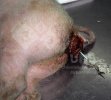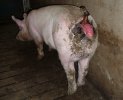Rectal prolapse
The eversion of the rectum.
Alternative names: Prolapse of the rectum
Information
It is common in sows and in growing pigs from 8 to 20 weeks old. The onset of the disease is sudden. Rectal prolapse often occurs in sows with a vaginal and cervical prolapse often during the last third of gestation, including the period immediately following farrowing.
Symptoms
All ages
- At first, the reddened mucosa of the rectum protrudes through the anal sphincter.
- It can return to its natural position on its own, or remain external- become swollen and filling with fluids.
- The rectum is prone to injuries, hemorrhage, and other animals biting or chewing on the protrusion.
- Pale pigs due to hemorrhage.
- Blood in stool.
- Swollen abdomen of pigs 2-4 weeks after the prolapse has been observed (constriction or rectal narrowing).
- Constipation.
- Sometimes death occurs.
Causes / Contributing Factors
The fundamental cause is an increase in abdominal pressure that pushes the rectum to the outside, the mucous membrane becomes swollen and then the animal has labored defecation.
The exact mechanisms are not known but the following can be considered as predisposition factors:
- Prolapses occurring after estrus associated with higher levels of sex hormones during this period.
- It may also occur in cases of constipation, for example if the sow receives little fiber in the diet.
- Penetration of the rectum during mating can result in a prolapse 24-48 hours later.
- Sows housed in stalls or if they are tethered in pens with floors that have an excessive slope towards the back.
- Rectal prolapse can occur when there is an increase in abdominal pressure; for example, a sow lying on a small resting area and having a step towards the area of defecation.
- Moldy feed or straw containing mycotoxins can cause rectal prolapse.
- Low-fiber diets can cause constipation and prolapse.
- Genetic factors may sometimes play a role.
The following may be considered causes or contributing factors, especially during the fattening stage:
- Diarrhea: animals exert effort to defecate (especially in case of Salmonella).
- Respiratory disease: excessive coughing increases abdominal pressure.
- When it is cold, the incidence of rectal prolapse increases. It is associated with low temperatures in the buildings and the tendency for pigs to pile up, further increasing abdominal pressure.
- Trauma.
- Tail docking: tails that are cut too short can damage nerves in the anal sphincter leading to the relaxation of the rectum.
Diagnosis
Based on clinical signs.
Control/Prevention
- Remove the animal from its pen, repair the prolapse, and keep it in position with suture around the rectum.
- Addressing predisposing conditions (diarrhea, respiratory outbreak, appropriate temperature).
Atlas of pathology
See images in the Altlas related to Rectal prolapse






